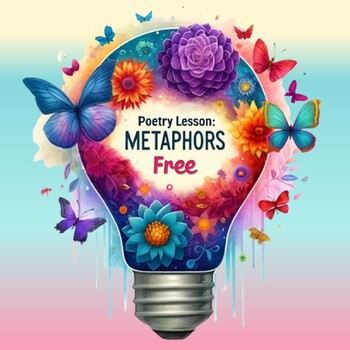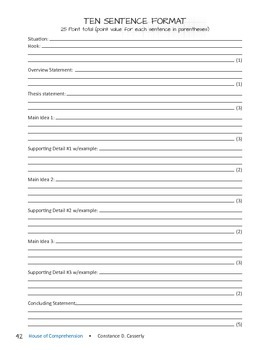Free Poetry Lesson on Metaphors
Description
This FREE lesson is a sample from one of my complete units on poetry. See the links below for more information.
❒ Lesson 4 (from the Thematic Poetry Unit) : Fun with metaphors – This lesson includes a journal prompt, a “Fun with Metaphors” worksheet to help students further understand metaphors, students will analyze William Blake’s “A Poison Tree,” and will complete the worksheet on the poem.
___________________________________________________________________________________________
An editable version the Thematic Poetry Unit can also be purchased using this link: ***EDITABLE Thematic Poetry Unit
Click here for a non-editable version of the unit Thematic Poetry Unit
__________________________________________________________________________________________
Description of the Thematic Poetry Unit – Summary of lessons included:
❒ Lesson 1: Introduction to poetry – Includes a journal prompt, notes on how to approach poetry, an activity to familiarize students with poetry further, and a review on figurative language (with notes.)
❒ Lesson 2: Figurative Language Review – The lesson includes a journal prompt (a creative poetry activity), students will play Figurative Language Jeopardy (PPT) to review figurative language.
❒ Lesson 3: Introduction to analysis – The lesson includes a journal prompt, students will learn to analyze poetry using Walt Whitman’s “When I heard the Learn’d Astronomer” and “The Quiet Patient Spider.”
❒ Lesson 4: Fun with metaphors – This lesson includes a journal prompt, a “Fun with Metaphors” worksheet to help students further understand metaphors, students will analyze William Blake’s “A Poison Tree,” and will complete the worksheet on the poem.
❒ Lesson 5: Fun with allusions – This lesson begins with a journal prompt, a “Fun with Allusions” worksheet, students analyze Simon and Garfunkel’s song “The Sound of Silence.” (poem not included) However, a blank (editable) page is included in the document to paste the lyrics from the internet. This will help you create a more cohesive looking unit.
❒ Lesson 6: Tone and Attitude – Students will do a video (or song version) comparison analysis by completing the “Video Comparison” worksheet.
❒ Lesson 7: Symbolism – Students will complete the “Fun with Idioms” worksheet, will analyze Robert Frost’s poems “The Road not Taken” and “Nothing Gold Can Stay,” they will complete the worksheets for both poems, and learn how to write a PEEL paragraph using the notes provided.
❒ Lesson 8: Writing about poetry – This is a writing clinic of sorts where students will learn to identify strong topic sentences and well-developed paragraphs. An example of a well-developed paragraph is included.
❒ Lesson 9: Historical allusions: This lesson begins with a journal prompt, students will analyze Cara Dillon’s song “There were Roses” and complete the accompanying worksheet. (Please note that this poem is not included.)
❒ Lesson 10: Thematic connections – Students will work in collaborative groups on the “Thematic Connections” worksheet, which compares two of the poems studied in the unit. *An optional activity is included: Students will write a comparative paragraph comparing one similar theme in both poems. An example of a paragraph is included.
❒ Lesson 11: Allusions and analysis – this lesson begins with a journal prompt, The study of Plato’s “The Allegory of the Cave” by watching a Ted Talk, analyzing Mumford and Son’s song “The Cave,” and completing the worksheet. (Please note that the song lyrics are not included.)
❒ Lesson 12: Connections – students will learn to make important connections in poetry by completing the worksheets of the “Battle of the Pronouns” and “Cave vs. Cave” to further develop the themes in Mumford and Son’s song “The Cave.”
❒ Lesson 13: Theme review – Students will refine and review how to develop a theme in a poem (which applies to any work of literature) by completing the worksheet “The Cave – Themes and Meanings,” students will then write a theme in paragraph form.
❒ Lesson 14: Evaluation (test) – editable with answer key and comment sheet to facilitate marking
You may also be interested in the following products:
❒Poetry Lesson: Analyzing Poetry
❒Poetry Unit for Senior Students
❒The Yellow Wallpaper No Prep Mini-Unit
❒Much Ado About Nothing No Prep Unit
❒Brave New World Student Notebook
It’s teaching made easy!
Total Pages
7 pages
Answer Key
Included
Teaching Duration
55 minutes


